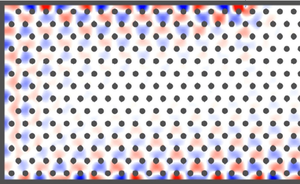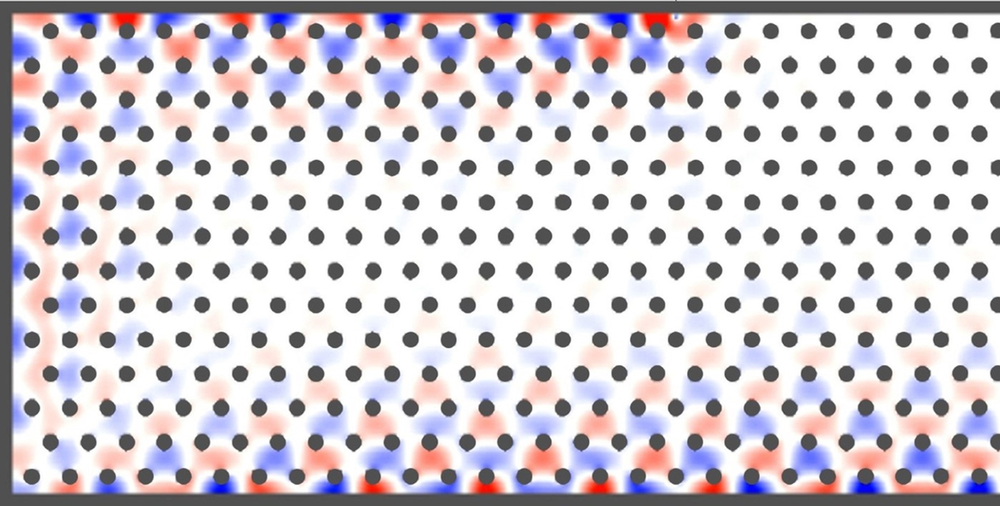Acoustic Structure Could Evade Sonar
Materials called topological insulators conduct electricity only along their surfaces and have a range of potential uses. A team in Singapore has now proposed a structure that could do the same thing for sound waves, causing them to be guided in just one direction around the surface of a region and to ignore imperfections that would scatter the sound in an ordinary material. If it can be built, such a structure might find uses in acoustic technologies, such as soundproofing and sonar stealth systems.
In topological insulators, electrons flow on the surface of a material and travel with less scattering from impurities than in ordinary conductors. The mathematical description of these materials treats the electrons as waves in a periodic structure and generates a range of frequencies (a band gap) in which waves cannot propagate through the interior. Researchers have high hopes for using them in new technologies, but they have also wondered whether the effects could be duplicated for other types of waves, such as light and mechanical vibrations [1,2]. Now Baile Zhang and co-workers at Nanyang Technological University in Singapore have created an acoustic topological insulator that they say could be used to control sound waves in new ways.
One example of a topological insulator is a two-dimensional material with a strong magnetic field applied along the 3rd dimension [3]. Under the right conditions, in response to the field the electrons move in circles arranged in a periodic pattern. But at the edges of the material, electrons can only execute half-circles. These semicircular routes can link up to form a circuit around the edge, a path that electrons can travel in only one direction (because of the direction of their orbits). In addition, current through this channel is resistant to the scattering that would usually occur if there were any flaws present in the crystal lattice, because the one-way motion prevents all backward scattering.
In the acoustic version proposed by Zhang and his colleagues, the periodic lattice of orbiting electrons is replaced by a two-dimensional array of spinning metal cylinders in a triangular lattice [4]. Each cylinder is surrounded by a fluid, which could simply be air, contained within a larger cylindrical shell made of a material that is transparent to sound waves. The space between the cylindrical shells is filled with the same fluid, but it’s stationary. The rotation of each metal cylinder produces a little vortex in its surrounding fluid within its shell.
Sound waves cannot propagate through the middle of this structure because the periodic pattern produces a sonic band gap, just like the electronic band gap in earlier topological insulators. But the edges are different—the rotating fluid supports propagation in one direction around the perimeter.
Zhang and his colleagues say that their design shouldn’t be too hard to make. Because the edge states can guide sound waves very precisely, says Zhang, such a structure might be useful for hiding objects from sonar. There are already proposals for doing this using sonic “invisibility shields” comparable to those devised for microwaves or visible light [5], but pronounced bumps on a surface can undermine such schemes. “An irregular protrusion is one of the biggest headaches for stealth engineers,” Zhang says. But a coating of an acoustic topological insulator would allow sound waves to be captured and guided in a single direction over the surface of an object of any shape.
“I think this strategy could be effective in creating structures with interesting acoustic properties, such as one-way waveguides,” says Vincenzo Vitelli of Leiden University in the Netherlands. He adds that current attempts to build such acoustic systems are looking promising.
This research is published in Physical Review Letters.
–Philip Ball
Philip Ball is a freelance science writer in London. His latest book is How Life Works (Picador, 2024).
References
- C. L. Kane and T. C. Lubensky, “Topological Boundary Modes in Isostatic Lattices,” Nature Phys. 10, 39 (2013)
- J. Paulose, B. G. Chen, and V. Vitelli, “Topological Modes Bound to Dislocations in Mechanical Metamaterials,” Nature Phys. 11, 153 (2015)
- F. D. M. Haldane and S. Raghu, “Possible Realization of Directional Optical Waveguides in Photonic Crystals with Broken Time-Reversal Symmetry,” Phys. Rev. Lett. 100, 013904 (2008)
- R. Fleury, D. L. Sounas, C. F. Sieck, M. R. Haberman, and A. Alu, “Sound Isolation and Giant Linear Nonreciprocity in a Compact Acoustic Circulator,” Science 343, 516 (2014)
- U. Leonhardt and T. Philbin, “Transformation Optics and the Geometry of Light,” Progr. Opt. 53, 69 (2009)





